- 1. Lead Generation Funnel: The Foundation of Customer Acquisition
- 2. Webinar Funnel: Converting Through Education
- 3. Product Launch Funnel: Building Anticipation for Maximum Impact
- 4. Tripwire Funnel: The Low-Risk Entry Strategy
- 5. Consultation Funnel: Converting High-Ticket Offers
- 6. Survey Funnel: Personalization at Scale
- 7. Cancellation Funnel: Turning Exits into Opportunities
- 8. Referral Funnel: Transforming Customers into Advocates
- Tools for Building CRM Funnels
- Conclusion: Choosing and Implementing Your CRM Funnels
Ultimate Guide: 8 Essential Types of CRM Funnels for Marketing
Discover the 8 essential types of CRM funnels for marketing and transform your customer journey. Learn how to choose, implement, and optimize each funnel for maximum ROI in 2024.
 Types of CRM funnels decoded: A marketing guide to 8 essential customer journey paths.
Types of CRM funnels decoded: A marketing guide to 8 essential customer journey paths.A CRM funnel is your strategic pathway for guiding potential customers from their first interaction with your brand through to becoming loyal advocates. Unlike traditional sales funnels that focus solely on conversions, modern CRM funnels help you build and nurture meaningful relationships at every stage of the customer journey.
Having implemented countless CRM funnels for businesses of all sizes, I can tell you that choosing the right funnel type for your goals can make the difference between struggling to convert leads and building a thriving customer base that grows itself.
In this comprehensive guide, you'll discover:
- 8 battle-tested CRM funnel types for different business goals
- Step-by-step implementation strategies for each funnel
- Key metrics to track and optimize
- Common pitfalls to avoid (and how to fix them)
- Tools and integrations to automate your funnels (examples and links at the bottom)
1. Lead Generation Funnel: The Foundation of Customer Acquisition
Think of a lead generation funnel as your business's first handshake with a potential customer. After working with hundreds of businesses, I've seen firsthand how a well-optimized lead generation funnel can transform your marketing efforts. Let me show you exactly how to build one that converts.
The Anatomy of an Effective Lead Generation Funnel
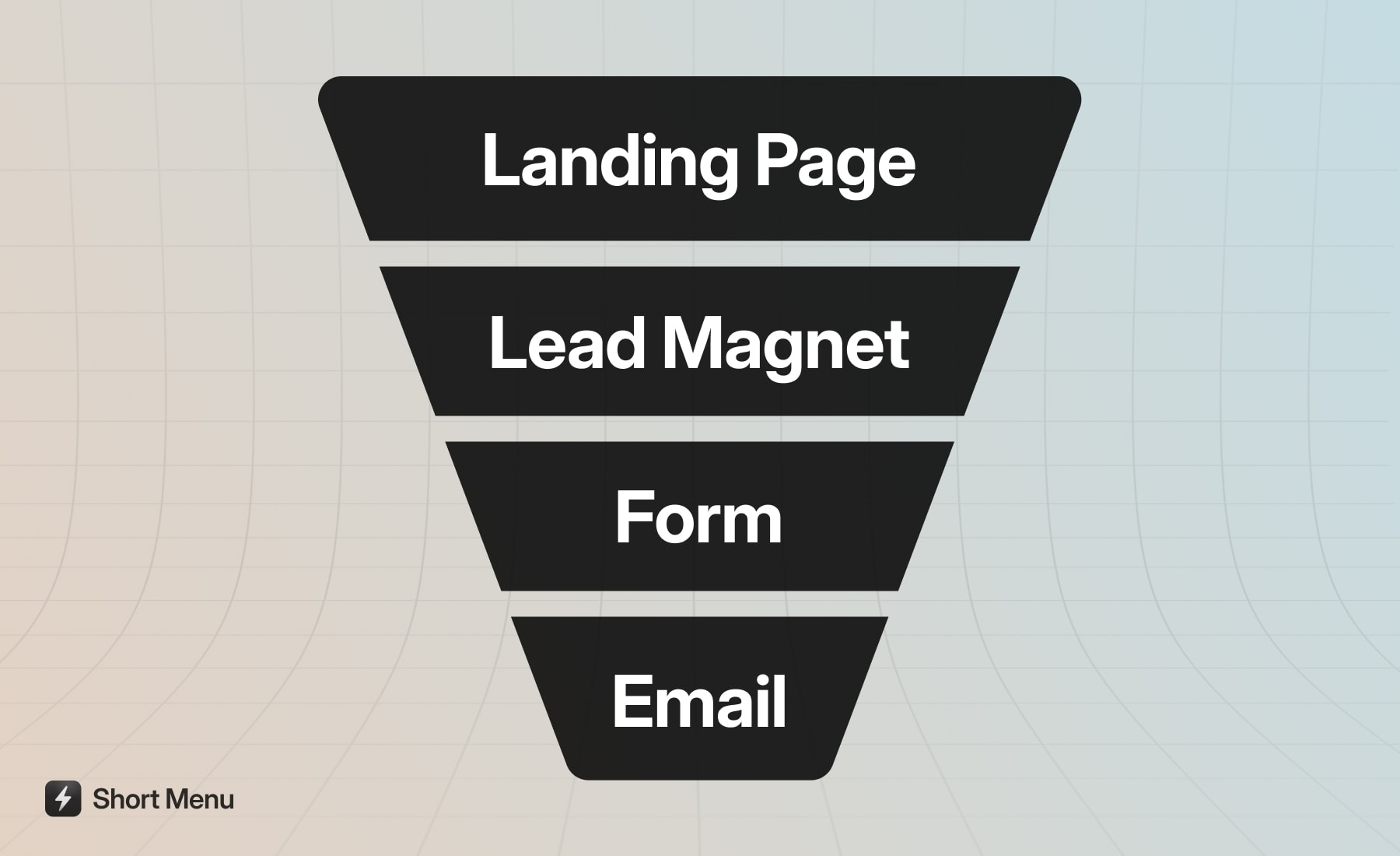 Breakdown of a lead generation funnel showing 4 key stages: Landing Page, Lead Magnet, Form, Email Nurture
Breakdown of a lead generation funnel showing 4 key stages: Landing Page, Lead Magnet, Form, Email Nurture
1. Landing Page Optimization
Your landing page should be like a well-organized store window – clean, appealing, and immediately showing visitors what they're looking for. I've seen conversion rates double simply by implementing the right elements in the right order.
Key Components:
- A compelling headline that mirrors the ad or link that brought them there (your visitors need instant confirmation they're in the right place)
- Clear, benefit-driven copy that speaks directly to your visitor's needs (remember, it's not about your features, it's about their problems)
- Social proof elements (testimonials, trust badges, client logos) strategically placed to build confidence
- A single, focused call-to-action that stands out (I've tested countless variations, and less is almost always more)
- Minimal navigation to prevent distraction (don't give them a reason to leave before converting)
2. Lead Magnet Creation
Here's something many marketers get wrong: they create lead magnets they think are valuable, instead of what their audience actually needs. From my experience working with successful campaigns, the best lead magnets solve a specific, pressing problem your audience faces right now.
Proven Lead Magnet Types:
- Industry reports with actionable insights
- Quick-start guides or checklists
- Free tools or templates
- Video training series
- Expert interviews or case studies
Pro Tip: Looking to distribute your lead magnet assets efficiently? Check out our guide on How to Use Dropbox for Your Lead Magnets for an organized and trackable setup.
3. Form Optimization
Let me share something counterintuitive I've learned: sometimes, adding the right field to your form can actually increase conversions. It's not always about having fewer fields – it's about asking the right questions at the right time.
Best Practices:
- Keep initial forms short (3-5 fields maximum)
- Only ask for information you'll actually use
- Use smart forms that adapt based on user behavior
- Include progress indicators for multi-step forms
- Offer immediate value after form submission
4. Email Nurture Sequence
This is where the magic happens. Your nurture sequence isn't just a series of emails – it's your opportunity to build a relationship with your future customers. I've seen businesses transform their conversion rates by simply restructuring their nurture sequence to focus on value first, sales second.
Essential Elements:
- Welcome email introducing your brand and setting expectations
- Value-driven content that educates and engages
- Segmented messages based on user behavior and preferences
- Clear calls-to-action that guide the next steps
- Automated triggers based on engagement levels
Measuring Success
If you can't measure it, you can't improve it. Here are the key metrics you need to track:
- Conversion rate from visitor to lead
- Form completion rates
- Lead magnet download rates
- Email open and click-through rates
- Lead quality scores
- Cost per lead
- Time to conversion
Common Pitfalls to Avoid
After analyzing hundreds of lead generation funnels, here are the most common mistakes I see businesses make:
- Overwhelming visitors with too many options (remember, clarity beats creativity)
- Creating generic lead magnets that don't address specific pain points
- Failing to segment and personalize follow-up communications
- Neglecting to test and optimize each funnel element
- Not having a clear nurturing strategy post-lead capture
2. Webinar Funnel: Converting Through Education
Let me tell you something fascinating: webinars consistently rank among the highest-converting funnel types I've worked with. Why? Because they combine two powerful elements: education and urgency. When done right, a webinar funnel doesn't just generate leads – it pre-sells your solution while building incredible authority in your space.
The Four Phases of a High-Converting Webinar Funnel
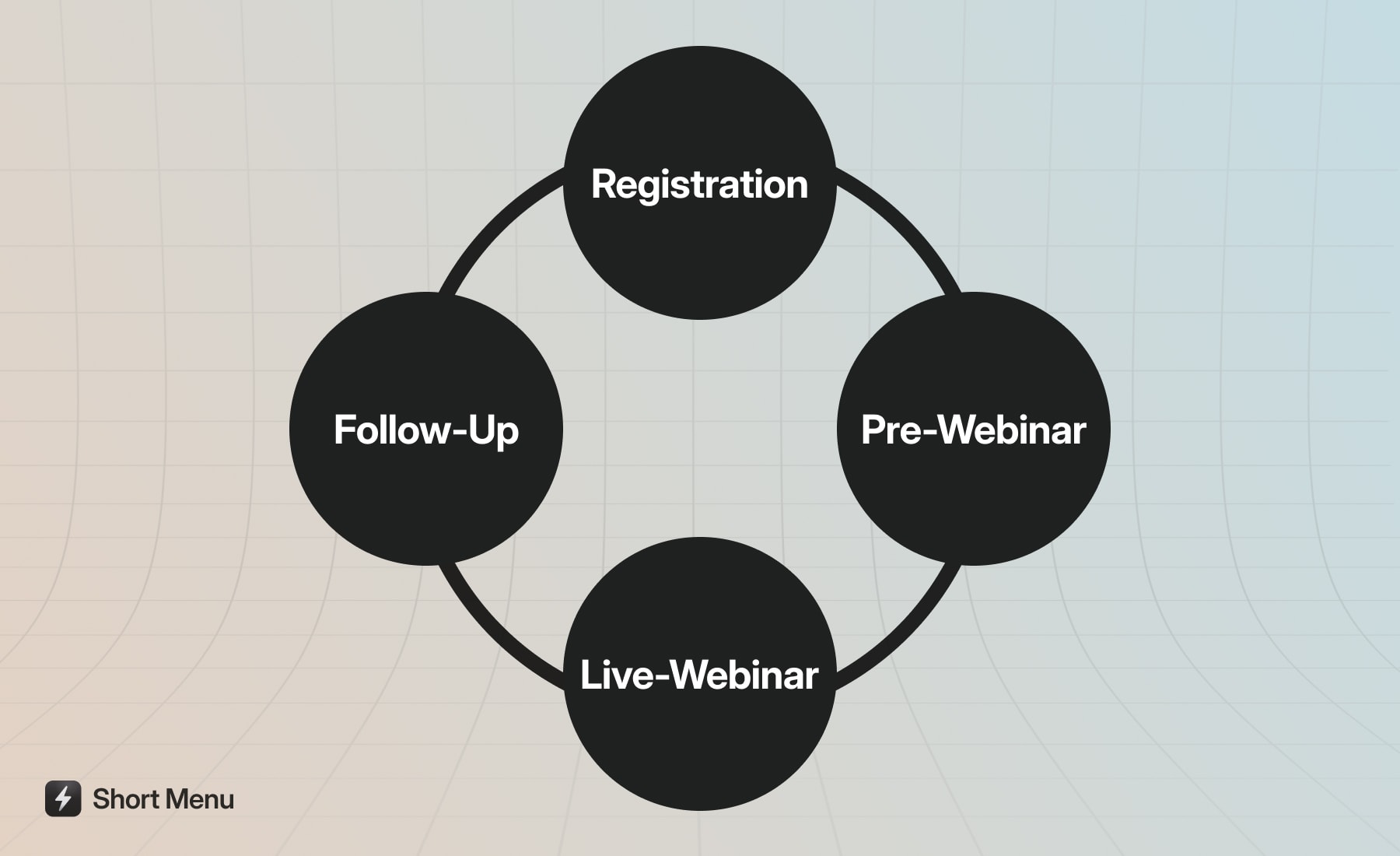 Timeline infographic illustrating the 4 phases of a successful webinar funnel
Timeline infographic illustrating the 4 phases of a successful webinar funnel
1. Registration Phase
The key to a successful webinar funnel starts long before the actual event. I've found that the most successful webinar campaigns nail these pre-event elements:
Registration Page Essentials:
- A benefit-focused headline (what specific problem will attendees solve?)
- Clear date and time with timezone converter
- 3-5 concrete learning outcomes
- Speaker credentials that matter to your audience
- Scarcity elements (limited seats, early-bird bonuses)
Pro Tip: Want to boost registration rates? Offer a valuable "show-up bonus" that attendees can only get by attending live. I've seen this increase live attendance rates by up to 70%.
2. Pre-Webinar Engagement
Here's a mistake I see too often: businesses think their job is done once someone registers. In reality, your pre-webinar sequence is crucial for building anticipation and ensuring attendance.
Engagement Sequence:
- Immediate confirmation email with calendar integration
- Value-packed content snippets (short videos, worksheets, or quick wins)
- Reminder sequence (7 days, 1 day, 1 hour, and 15 minutes before)
- Text message reminders for higher-ticket offerings
- Social proof from past attendees
3. Live Webinar Experience
Your webinar isn't just a presentation – it's an experience. After running hundreds of webinars, I've discovered this winning structure:
Webinar Flow:
- Quick wins in the first 5 minutes (hook them early)
- Interactive elements every 15-20 minutes (polls, questions, exercises)
- Strategic story-telling to illustrate key points
- Clear transition to your offer
- Q&A session that addresses common objections
4. Post-Webinar Follow-Up
This is where most webinar funnels fall short. Your post-webinar sequence should be just as strategic as the event itself:
Follow-Up Strategy:
- Immediate replay access (limited time creates urgency)
- Segmented follow-up based on attendance and engagement
- Special offer with genuine scarcity
- Case studies and testimonials
- Personal outreach for high-ticket offers
Automation and Tools
To run a webinar funnel effectively, you'll need:
- Reliable webinar platform (I recommend choosing based on your audience size and interaction needs)
- Email automation system
- Registration page builder
- CRM integration for tracking
- Chat or messenger integration for engagement
Measuring Webinar Funnel Success
Track these metrics to optimize your webinar funnel:
- Registration rate (signups/landing page visitors)
- Attendance rate (attendees/registrants)
- Engagement metrics (poll participation, questions asked)
- Replay views
- Conversion rate to offer
- Cost per attendee
- Lifetime value of webinar customers
Common Challenges and Solutions
I've helped businesses overcome these frequent webinar funnel challenges:
- Low Registration Rates
- Solution: Test different headlines and benefits on your registration page
- Add social proof from past attendees
- Use targeted paid traffic to reach the right audience
- Poor Attendance Rates
- Solution: Implement a multi-channel reminder sequence
- Offer compelling show-up bonuses
- Choose optimal timing for your audience
- Weak Engagement
- Solution: Include interactive elements throughout
- Tell stories that resonate with your audience
- Use pattern interrupts to maintain attention
- Low Conversion Rates
- Solution: Strengthen your pre-webinar content
- Improve your offer transition
- Test different pricing and bonuses
3. Product Launch Funnel: Building Anticipation for Maximum Impact
If there's one thing I've learned from managing dozens of product launches, it's this: a successful launch isn't about the day you open cart – it's about the story you tell in the weeks leading up to it. A well-crafted product launch funnel creates such intense anticipation that your audience is ready to buy before you even make the offer.
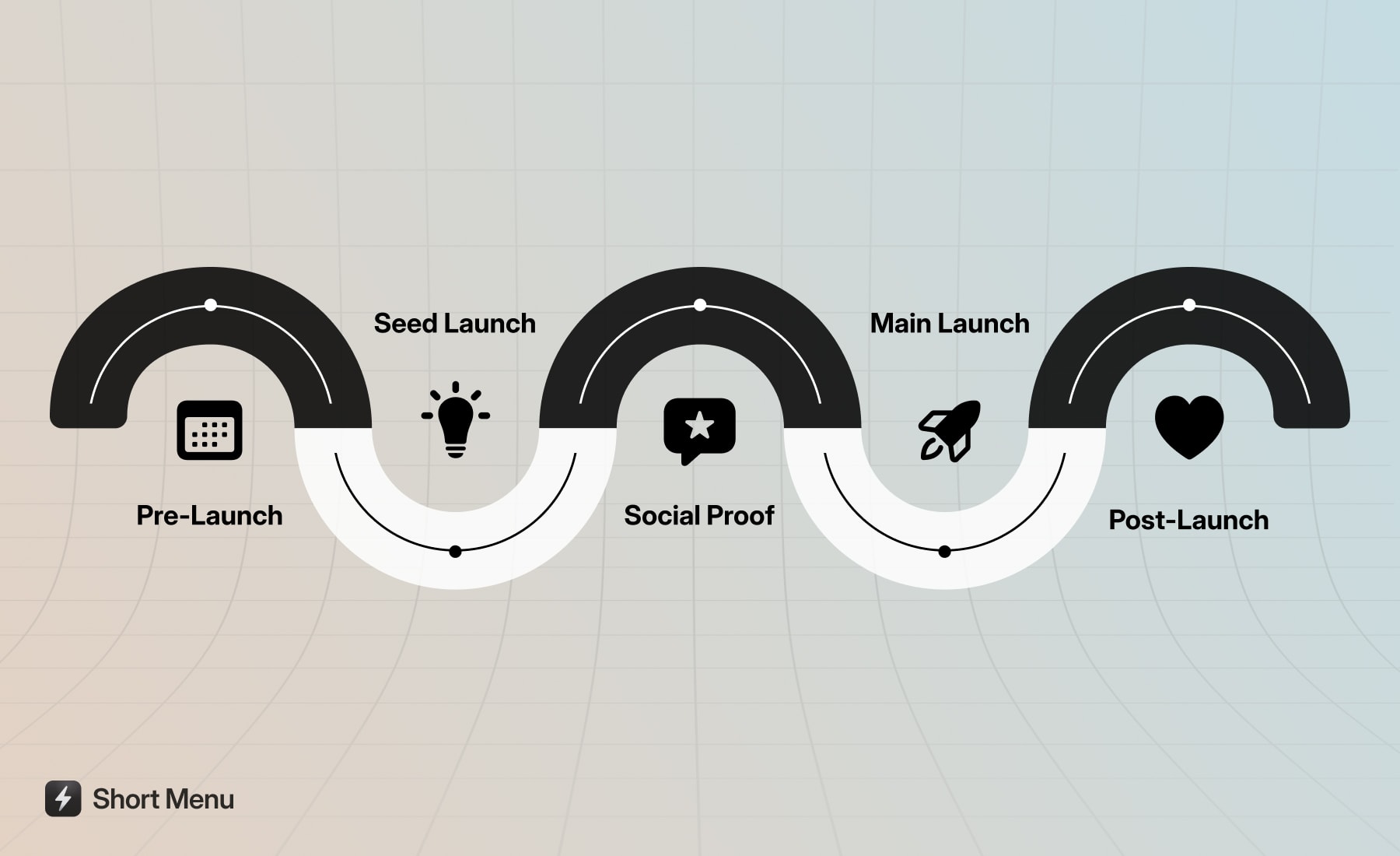 Step-by-step product launch funnel timeline: Pre-Launch, Social Media, Sales, Post-Launch
Step-by-step product launch funnel timeline: Pre-Launch, Social Media, Sales, Post-Launch
The Psychology of a Magnetic Launch
I've seen businesses transform their launch results by understanding one crucial principle: people don't just buy products; they buy into movements. Your launch funnel needs to create a sense of momentum that turns your product release into an event worth talking about.
Key Launch Phases:
- Pre-launch content that challenges the status quo
- Strategic "seed launching" to early adopters
- Public beta testing for social proof
- Main launch sequence with clear scarcity
- Post-launch relationship building
Pro Tip: Consider implementing a "founders' club" or early access list. I've seen this strategy not only drive early sales but create valuable brand ambassadors for your main launch.
Breaking Down the Launch Phases
1. Pre-Launch Content Strategy
Your pre-launch content needs to do more than just inform – it should create paradigm shifts in how your audience thinks about their problems. Here's what works consistently:
Content Framework:
- Problem Awareness Content: Challenge existing beliefs
- Solution Awareness Content: Introduce new possibilities
- Product Awareness Content: Position your unique approach
- Proof Content: Share case studies and early results
2. Seed Launch Sequence
Before your main launch, select a small group of engaged followers for an exclusive first look. This accomplishes two crucial things: it generates testimonials and helps you refine your offering.
Implementation Steps:
- Identify your most engaged subscribers
- Create an exclusive "beta testing" opportunity
- Gather detailed feedback and testimonials
- Refine your offering based on real user experience
- Transform beta testers into launch ambassadors
3. Social Proof Integration
Here's something many product launches miss: you need to be collecting and strategically deploying social proof throughout the entire launch process, not just during the sale period.
Types of Social Proof to Collect:
- Beta tester success stories
- Expert endorsements
- Results screenshots
- Video testimonials
- Social media mentions
4. Main Launch Execution
Having managed launches that generated six and seven figures in revenue, I can tell you that timing is everything. Here's the sequence that consistently delivers results:
Launch Timeline:
- Day 1-3: Open cart with early-bird bonus
- Day 4-5: Share case studies and testimonials
- Day 6-7: Address common objections
- Day 8-9: Announce cart closing
- Day 10: Final call with special bonus
Pro Tip: Create genuine scarcity by offering launch-exclusive bonuses that truly add value. Artificial scarcity can damage trust, but real scarcity drives action.
5. Post-Launch Nurture
The biggest mistake I see businesses make? Treating the end of the launch as the end of the relationship. Your post-launch sequence is crucial for:
- Reducing refunds
- Generating success stories
- Creating brand advocates
- Setting up your next launch
Launch Metrics That Matter
Focus on these key performance indicators:
- Email open rates during pre-launch
- Engagement with pre-launch content
- Seed launch conversion rate
- Main launch conversion rate
- Average cart value
- Refund rate
- Customer satisfaction scores
Technology Stack for Launch Success
You'll need these tools to execute effectively:
- Email marketing platform with automation
- Landing page builder
- Video hosting solution
- Social proof collection tool
- Shopping cart with countdown capabilities
Common Launch Challenges
- Poor Timing
- Solution: Research your audience's buying patterns
- Test different launch windows
- Consider seasonal factors
- Weak Pre-Launch Engagement
- Solution: Create more interactive content
- Use micro-commitments
- Build community around your launch
- Launch Fatigue
- Solution: Vary your content formats
- Use pattern interrupts
- Keep emails concise but impactful
- Low Conversion Rate
- Solution: Strengthen your value proposition
- Add social proof strategically
- Test different price points and payment plans
4. Tripwire Funnel: The Low-Risk Entry Strategy
Here's a powerful truth about customer psychology: once someone makes a small purchase from you, they're far more likely to make a larger one. This is where tripwire funnels shine. I've seen businesses transform their customer acquisition by mastering this approach – offering a low-cost, high-value entry point that leads to bigger opportunities.
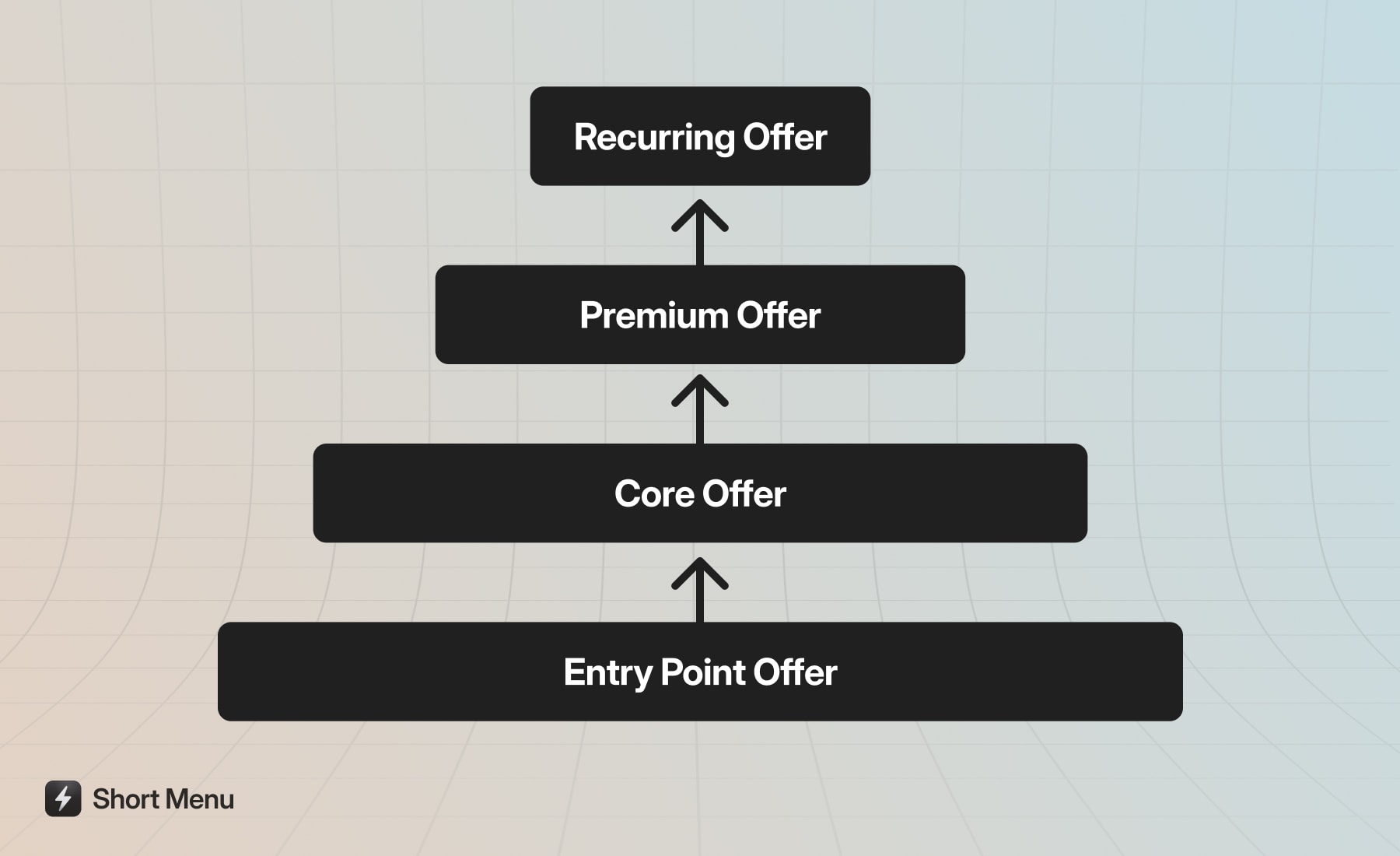 Value ladder diagram showing the progression from tripwire offers to premium services
Value ladder diagram showing the progression from tripwire offers to premium services
The Art of the Perfect Tripwire
The secret to a successful tripwire isn't just making it cheap – it's making it irresistible. Your offer should be so valuable that potential customers think, "This must be a mistake... I need to grab this now!"
Tripwire Characteristics:
- Solves an immediate, specific problem
- Delivers quick wins
- Demonstrates your expertise
- Sets up the need for your core offer
- Priced between $5-$50 (sweet spot I've found through testing)
Pro Tip: The most effective tripwires are often "splinters" from your main product – take one valuable piece of your core offering and package it as a standalone solution.
Key Components of a Tripwire Funnel
1. Entry Point Offer
Your tripwire offer needs to hit the sweet spot between perceived value and price point. After testing hundreds of tripwire offers, here's what I've found works best:
Winning Tripwire Formats:
- PDF guides with actionable templates
- Video tutorials with quick wins
- Software tools with limited features
- Physical products at cost (great for ecommerce)
- Mini-courses that solve one specific problem
2. Immediate Upsell Sequence
The moments right after someone purchases your tripwire are golden. They're in a buying mood and have just experienced a win – this is your opportunity to present your core offer.
Upsell Strategy:
- Thank you page with natural transition to core offer
- One-time-only special pricing
- Bundle deals that complement the tripwire
- Extended payment plans
- Fast-action bonuses
3. Value Ladder Integration
Here's where many businesses go wrong: they treat the tripwire as a standalone product rather than the first step in a value journey. Your funnel should create a clear path to higher-value offerings.
Value Ladder Structure:
- Tripwire ($5-$50): Instant solution to one problem
- Core Offer ($297-$997): Comprehensive solution
- Premium Offer ($997+): Done-for-you or high-touch service
- Recurring Offer: Ongoing support or membership
Pro Tip: Create a "success path" document that shows customers exactly how each offer builds on the previous one. I've seen this increase ascension rates by up to 40%.
4. Follow-Up Automation
The key to maximizing tripwire funnel ROI is in the follow-up. Your automation should nurture customers based on their behavior and purchasing patterns.
Automation Sequences:
- Purchase confirmation and delivery
- Implementation support
- Success celebration and case study request
- Strategic upsell timing
- Re-engagement for inactive customers
Measuring Tripwire Success
Track these metrics to optimize your funnel:
- Tripwire conversion rate
- Average cart value
- Upsell take-rate
- Customer lifetime value
- Refund rate by offer type
- Time to first upsell
- Cost per acquisition
Common Tripwire Challenges
- Price Positioning Issues
- Solution: Test different price points
- Emphasize the gap between perceived value and price
- Add time-sensitive bonuses
- Poor Upsell Conversion
- Solution: Improve the connection between tripwire and core offer
- Strengthen your upsell copy
- Test different upsell timing
- Customer Success Gaps
- Solution: Create better onboarding
- Provide quick wins
- Add implementation support
- Value Perception
- Solution: Enhance your offer presentation
- Add more social proof
- Improve your product packaging
Remember, a tripwire funnel isn't about making money on the front end – it's about acquiring customers you can serve at a higher level. Focus on delivering massive value at each step, and the ascension will happen naturally.
5. Consultation Funnel: Converting High-Ticket Offers
If you're selling services or high-ticket products ($2,000+), a consultation funnel is likely your most powerful tool. After helping dozens of service providers optimize their consultation funnels, I can tell you that the key isn't getting more calls booked – it's getting the right calls booked with pre-qualified, ready-to-buy prospects.
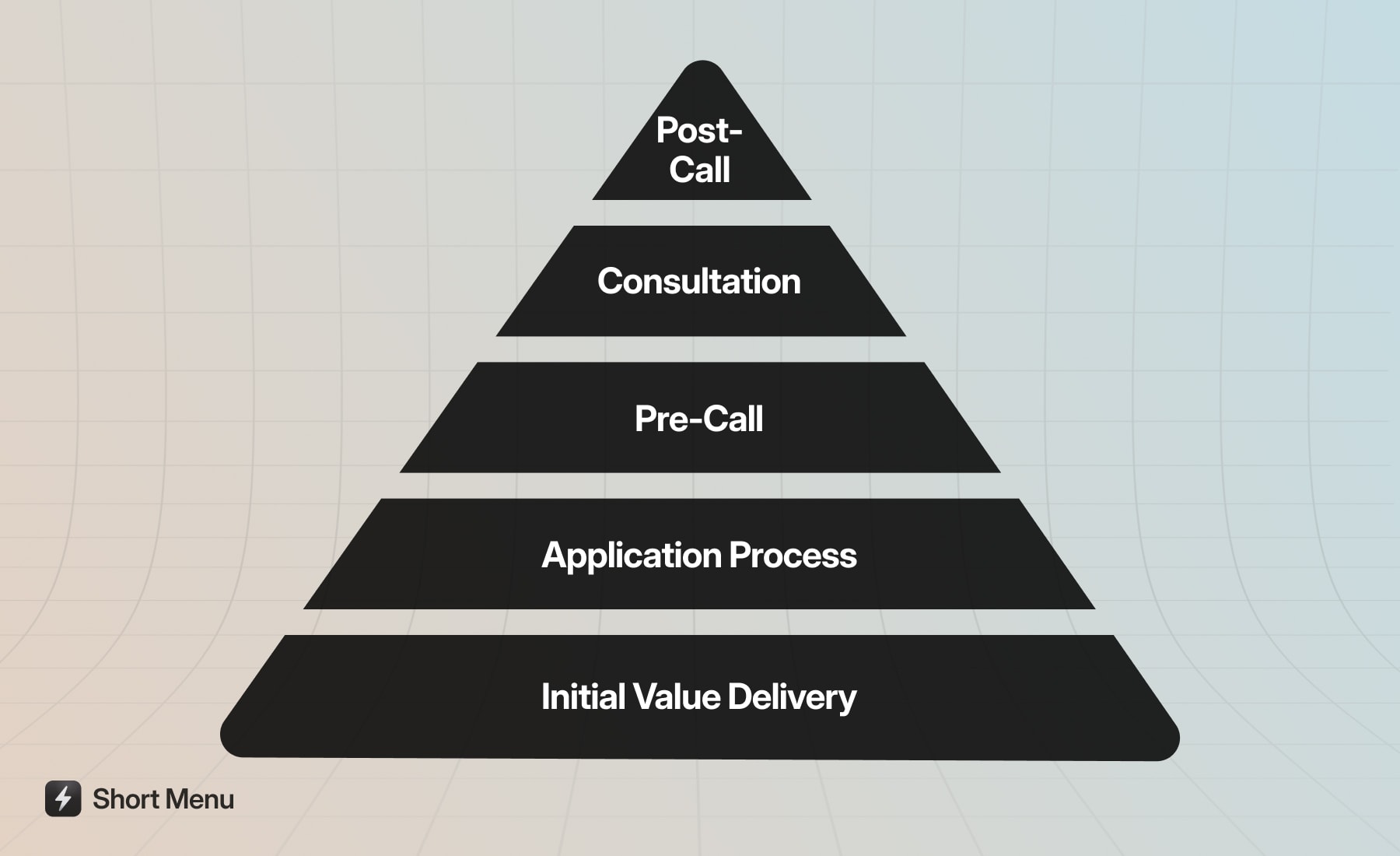 Pyramid diagram illustrating the 5 levels of a high-ticket consultation funnel
Pyramid diagram illustrating the 5 levels of a high-ticket consultation funnel
The High-Ticket Consultation Framework
The goal is to ensure that by the time someone gets on a call with you, they're already 80% sold. Here's how to structure your funnel to make this happen:
Pre-Qualification Elements:
- Value-packed content that demonstrates expertise
- Clear positioning of your unique approach
- Case studies showing concrete results
- Application form that filters tire-kickers
- Scheduling system with strategic availability
Pro Tip: Want to instantly increase your show-up rates? Require a small commitment deposit ($50-100) that applies to your service if they purchase. I've seen this reduce no-shows by up to 90% while pre-qualifying serious buyers.
Breaking Down the Consultation Funnel Components
1. Initial Value Delivery
Before asking for the consultation, you need to demonstrate your expertise. Here's the content sequence I've found most effective:
Authority-Building Content:
- In-depth case study video (with real results)
- Free training that challenges common industry myths
- PDF framework showing your unique methodology
- Client success stories highlighting ROI
- Behind-the-scenes look at your process
2. Application Process
Your application form isn't just about collecting information – it's your first filter for quality prospects. Design it to:
Key Application Elements:
- Current situation assessment
- Budget qualification questions
- Timeline for implementation
- Goals and desired outcomes
- Current challenges they're facing
- Previous solutions they've tried
3. Pre-Call Nurture Sequence
The period between application submission and the actual call is crucial. Here's what your sequence should include:
Pre-Call Nurturing:
- Immediate confirmation with next steps
- Preparation materials they need to review
- Case study relevant to their situation
- Reminder sequence (3 days, 1 day, 2 hours before)
- Text message confirmation
Pro Tip: Send a short video message introducing yourself after they book. I've found this personal touch increases show-up rates by 35% and improves call quality significantly.
4. Consultation Call Structure
After conducting thousands of sales calls, here's the structure that consistently converts:
Call Framework:
- Brief rapport building (5 minutes)
- Current situation deep dive (10 minutes)
- Future vision exploration (10 minutes)
- Gap analysis and solution presentation (20 minutes)
- Investment discussion and next steps (15 minutes)
5. Post-Call Follow-Up
Your follow-up sequence is just as important as the call itself:
Follow-Up Strategy:
- Same-day call summary and proposal
- Social proof specific to their situation
- Limited-time booking incentive
- Clear next steps and timeline
- Re-engagement sequence for those who don't convert
Technology Stack for Consultation Funnels
Essential tools you'll need:
- Calendar booking system with reminders
- Video conferencing platform
- CRM for tracking prospects
- Proposal creation software
- Document signing solution
- Payment processing system
Key Metrics to Track
Monitor these metrics to optimize your funnel:
- Application-to-booking ratio
- Show-up rate
- Consultation-to-client conversion rate
- Average client value
- Time from first touch to consultation
- Follow-up sequence engagement
- Cost per booked call
Common Consultation Funnel Challenges
- Low-Quality Applications
- Solution: Strengthen pre-qualification content
- Add more specific questions to application
- Require minimum budget threshold
- High No-Show Rates
- Solution: Implement booking deposit
- Improve reminder sequence
- Add text message confirmations
- Send personal video message
- Poor Close Rates
- Solution: Enhance pre-call nurture
- Refine call structure
- Improve objection handling
- Test different pricing presentations
- Long Sales Cycles
- Solution: Add urgency elements
- Strengthen follow-up sequence
- Test different offer structures
- Improve value presentation
6. Survey Funnel: Personalization at Scale
Here's what many marketers miss about surveys: they're not just data collection tools – they're powerful conversion machines when used correctly. I've seen businesses double their conversion rates by replacing traditional lead magnets with interactive surveys that guide prospects to personalized solutions.
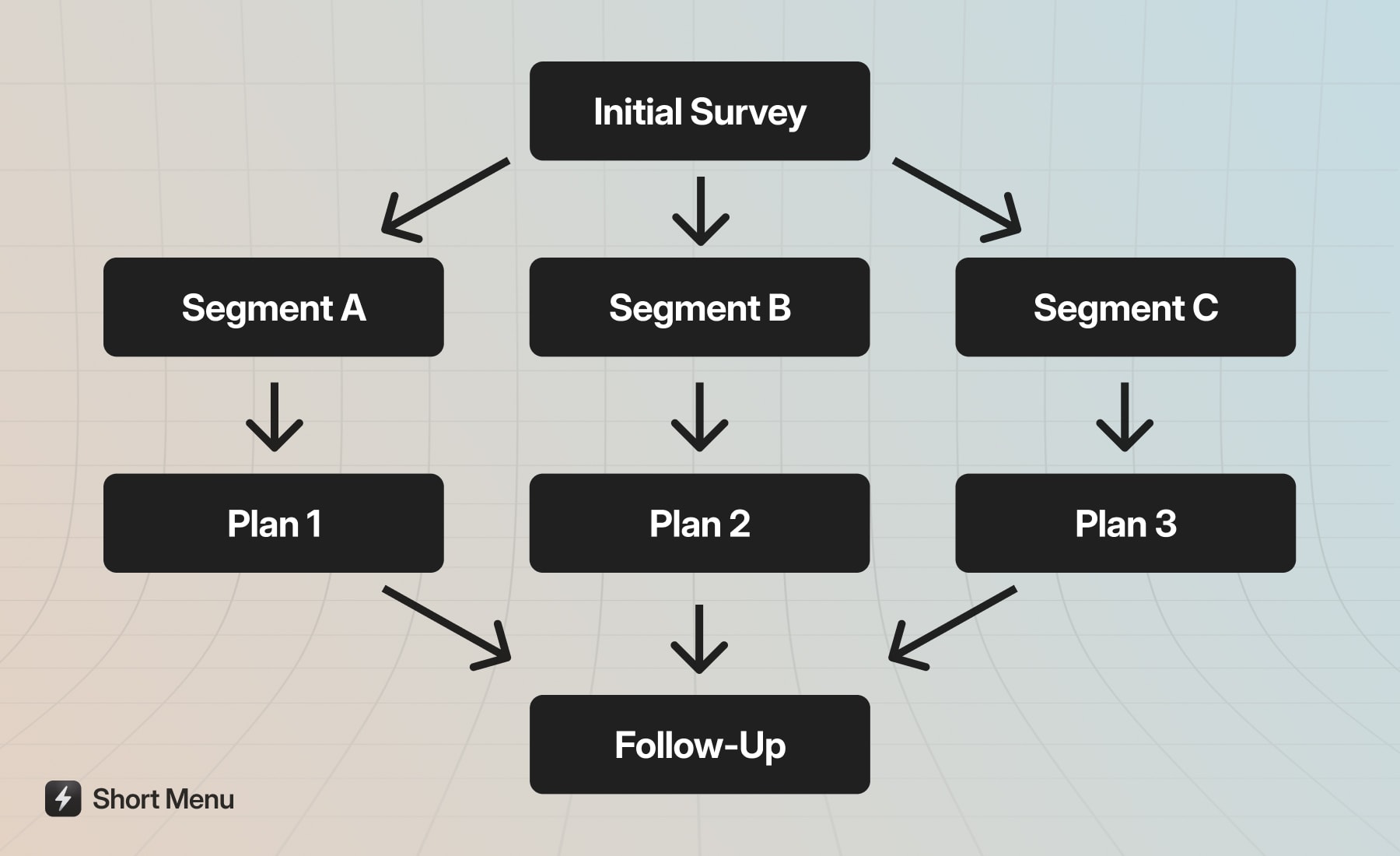 Flowchart showing how survey responses lead to personalized marketing paths and outcomes
Flowchart showing how survey responses lead to personalized marketing paths and outcomes
The Power of Interactive Segmentation
The magic of survey funnels lies in making prospects feel understood before you make any offer. When someone tells you their specific challenges, you can position your solution in a way that speaks directly to their situation.
Key Benefits:
- Instant audience segmentation
- Higher engagement rates
- Personalized follow-up sequences
- Better qualification of leads
- Data-driven product development
Pro Tip: The most effective survey funnels don't feel like surveys at all – they feel like personalized consultation sessions. Frame your questions as "Let me help you find the perfect solution" rather than "Please fill out this survey."
Essential Components of a High-Converting Survey Funnel
1. Survey Design
After testing hundreds of survey variations, I've found these elements consistently drive the highest engagement and completion rates:
Survey Structure:
- Hook question that piques interest
- 3-5 multiple choice questions (keep it short!)
- One open-ended question for personal expression
- Progress bar showing completion
- Micro-commitments that build investment
Question Types That Convert:
- Assessment of current situation
- Biggest challenge question
- Goal identification
- Budget range (if relevant)
- Timeline for implementation
2. Results Delivery
This is where most survey funnels fall flat. Don't just show generic results – create an experience:
Results Page Elements:
- Personalized analysis based on answers
- Custom score or assessment
- Comparison to industry benchmarks
- Specific next steps based on responses
- Tailored solution recommendations
Pro Tip: Create different results pages for each major segment of your audience. I've seen conversion rates increase by 150% when delivering truly personalized result experiences.
3. Segmented Follow-Up Sequences
Your follow-up needs to reference their specific survey answers. Here's how to structure it:
Sequence Framework:
- Immediate personalized email with results
- Custom content sequence based on challenges
- Targeted case studies matching their situation
- Personalized offer based on survey responses
- Re-engagement sequence for non-responders
4. Data Collection and Analysis
Make your survey funnel work double-duty by collecting valuable market research:
Key Insights to Track:
- Common pain points by segment
- Budget distributions
- Timeline patterns
- Feature preferences
- Objection patterns
Technology Requirements
Essential tools for an effective survey funnel:
- Interactive survey platform
- Email marketing system with segmentation
- CRM for response tracking
- Landing page builder
- Analytics tools for data collection
Metrics That Matter
Track these KPIs to optimize your survey funnel:
- Survey start rate
- Completion rate
- Time to completion
- Drop-off points
- Response patterns
- Conversion rate by segment
- Email sequence engagement
Common Survey Funnel Challenges
- Low Completion Rates
- Solution: Shorten survey length
- Add progress indicators
- Improve question engagement
- Test different question orders
- Poor Data Quality
- Solution: Use conditional logic
- Implement answer validation
- Add helpful context to questions
- Test questions for clarity
- Weak Conversions
- Solution: Improve results page personalization
- Strengthen call-to-action
- Test different offer presentations
- Enhance follow-up sequences
- Technical Integration Issues
- Solution: Use native integrations when possible
- Document data flow requirements
- Test end-to-end user experience
- Regular system audits
Remember: The goal of your survey funnel isn't just to collect data – it's to create a personalized journey that makes your prospect feel understood and guided toward the right solution. When done right, survey funnels can be your most powerful tool for qualifying leads and personalizing your marketing at scale.
7. Cancellation Funnel: Turning Exits into Opportunities
Most businesses focus all their energy on acquisition funnels while neglecting one of their most valuable assets: existing customers who are considering leaving. After helping numerous SaaS companies optimize their cancellation processes, I can tell you that a well-designed cancellation funnel can save 20-40% of cancelling customers.
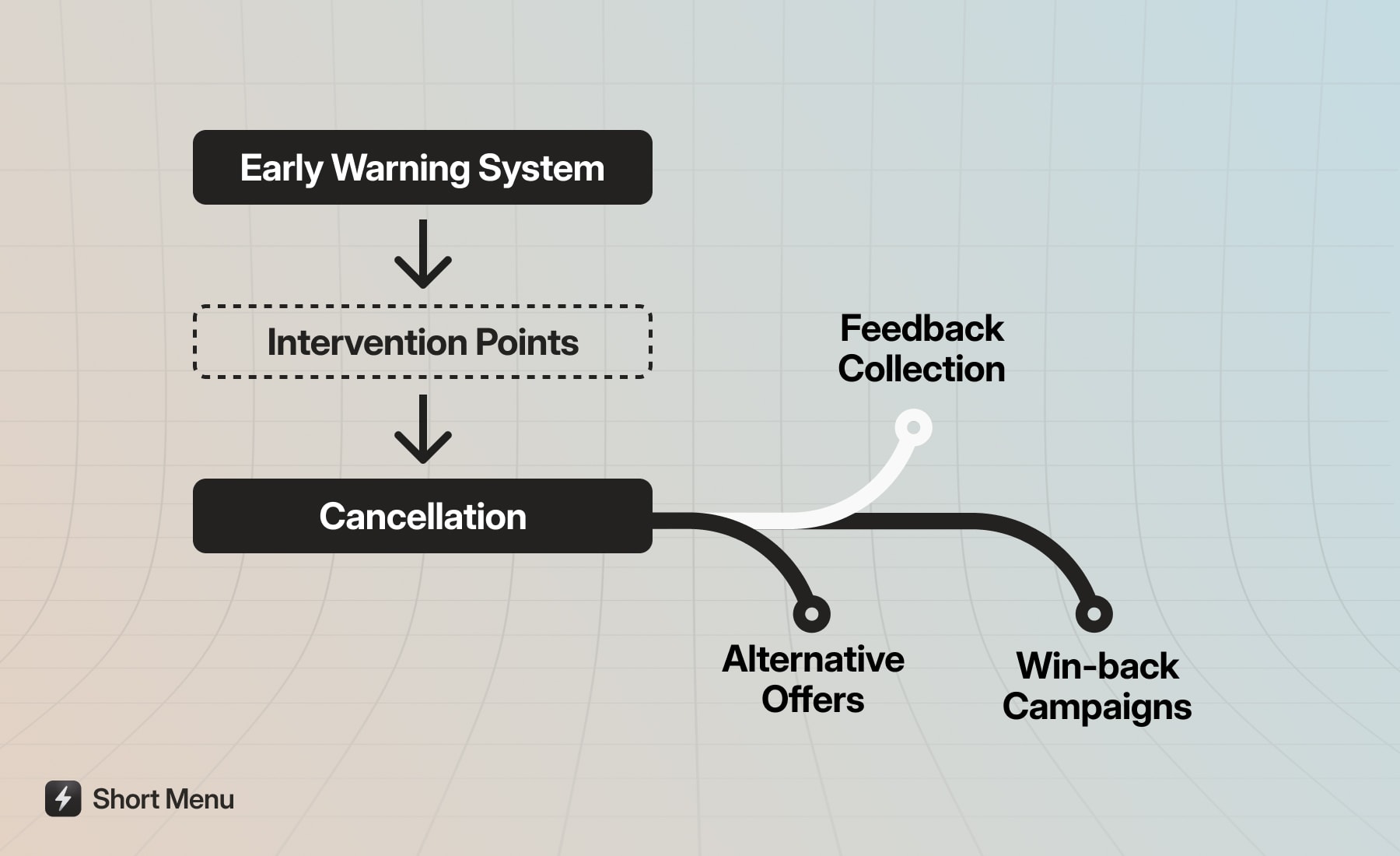 Customer retention flowchart illustrating recovery pathways in a cancellation funnel
Customer retention flowchart illustrating recovery pathways in a cancellation funnel
The Psychology of Customer Retention
The key to an effective cancellation funnel isn't about making it difficult to cancel – it's about understanding and addressing the real reasons customers want to leave. When done right, your cancellation process becomes a valuable feedback loop and retention tool.
Core Principles:
- Make cancellation straightforward but value-focused
- Offer relevant alternatives before final cancellation
- Collect actionable feedback
- Leave the door open for return
- Turn cancellations into learning opportunities
Pro Tip: Never hide your cancellation button. Instead, surround it with value reminders and alternative solutions. I've seen this approach not only retain more customers but also increase trust and lifetime value for those who do stay.
Key Components of an Effective Cancellation Funnel
1. Pre-Cancellation Intervention
The best cancellation prevention happens before customers reach for the cancel button. Here's what I've found works best:
Early Warning System:
- Usage pattern monitoring
- Engagement score tracking
- Support ticket analysis
- NPS score changes
- Feature adoption rates
Proactive Outreach:
- Check-in emails for at-risk customers
- Educational content for underutilized features
- Success stories matching their use case
- Personal reaching out from customer success
- Exclusive webinars or training sessions
2. The Cancellation Flow
When someone does click "cancel," your flow should be both respectful and strategic:
Essential Steps:
- Quick feedback collection (single question first)
- Targeted solutions based on cancellation reason
- Alternative plan options if price is the issue
- Pause account option instead of full cancellation
- Final attempt with special offer
Pro Tip: Create specific retention offers for each major cancellation reason. For example, if they say "too expensive," offer a lighter plan. If they say "don't use it enough," offer a success coaching session.
3. Post-Cancellation Strategy
Your relationship with the customer isn't over after cancellation:
Recovery Sequence:
- Immediate thank you and door-open message
- 7-day check-in with targeted content
- 30-day win-back offer
- Quarterly updates on new features
- Annual "we've missed you" campaign
4. Data Collection and Analysis
Turn every cancellation into valuable business intelligence:
Key Metrics to Track:
- Cancellation reasons by segment
- Successful retention tactics
- Customer lifetime value impact
- Feature usage patterns
- Support interaction history
Essential Tools for Cancellation Funnels
Your tech stack should include:
- Customer health scoring system
- Automated intervention triggers
- Feedback collection tools
- Email automation platform
- Analytics for tracking patterns
Success Metrics
Monitor these KPIs:
- Saved customer rate
- Average save value
- Time to re-engagement
- Win-back campaign success
- Customer lifetime value
- Churn rate by segment
- Feedback completion rate
Common Challenges and Solutions
- High Immediate Cancellation Rate
- Solution: Improve value visibility
- Add social proof elements
- Enhance onboarding experience
- Implement usage triggers
- Poor Feedback Quality
- Solution: Simplify feedback process
- Ask specific, actionable questions
- Follow up personally on detailed responses
- Offer incentive for comprehensive feedback
- Failed Save Attempts
- Solution: Test different offer types
- Improve timing of interventions
- Personalize retention offers
- Train customer success team
- Win-back Campaign Failures
- Solution: Segment your approaches
- Test different timing sequences
- Improve value propositions
- Use customer feedback to inform offers
The key to a successful cancellation funnel is balance – make it easy enough to cancel that you maintain trust, but valuable enough to stay that you maximize retention. Every interaction in your cancellation process should demonstrate your commitment to customer success.
8. Referral Funnel: Transforming Customers into Advocates
Here's something I've learned from analyzing thousands of customer acquisition channels: referrals consistently produce the highest-quality leads with the lowest acquisition costs. But here's the catch – referrals don't happen by accident. You need a systematic approach to turn happy customers into active advocates.
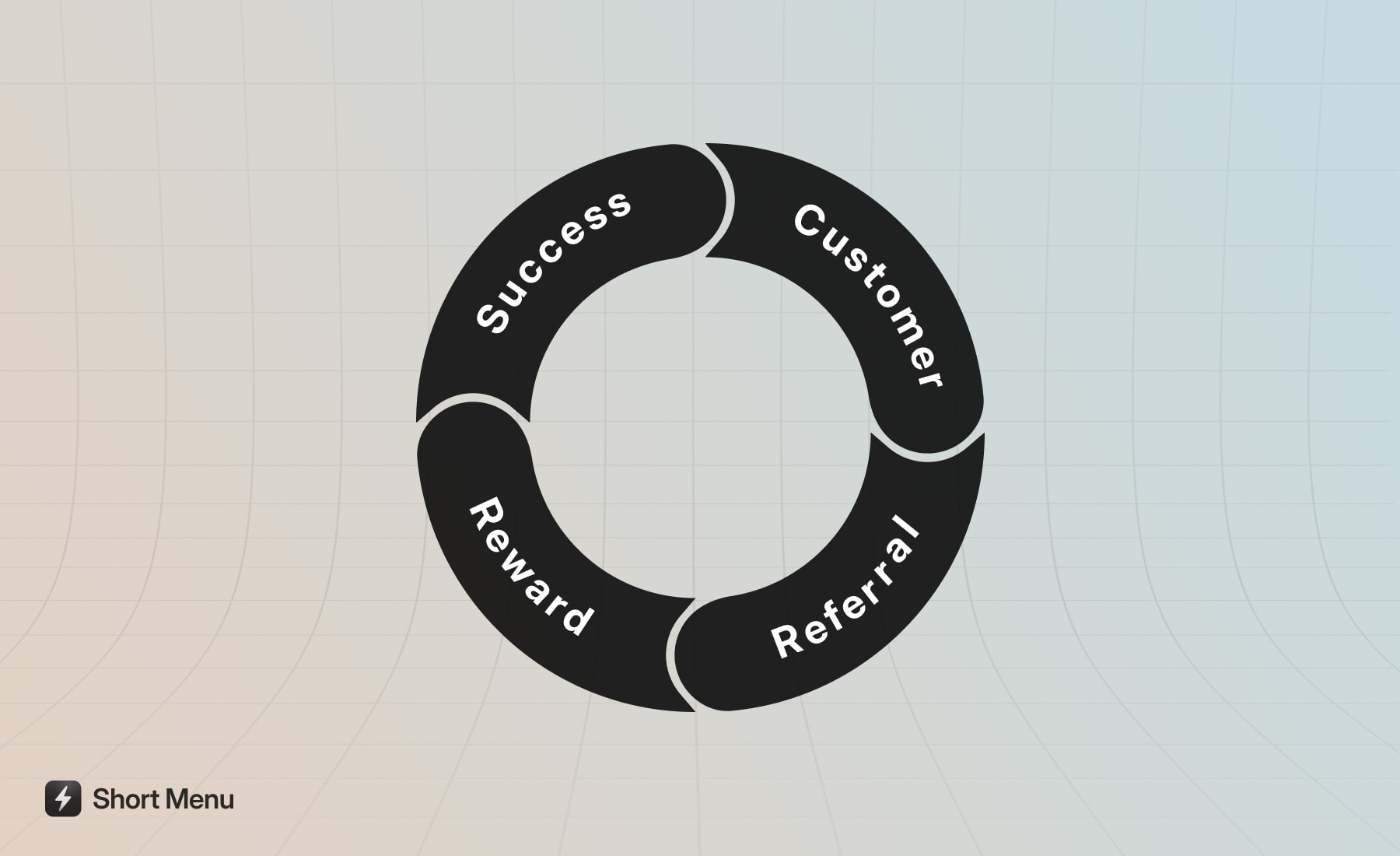 Circle diagram showing the mechanics of a referral program
Circle diagram showing the mechanics of a referral program
The Science of Referral Psychology
The most successful referral funnels tap into core human motivations:
- Reciprocity (giving back after receiving value)
- Social currency (looking good to peers)
- Altruism (helping others succeed)
- Personal gain (rewards and recognition)
- Community belonging (being part of something bigger)
Pro Tip: The best referral programs aren't just about rewards – they're about making customers feel like valued partners in your success. I've seen referral rates triple when companies shift from a pure incentive model to a partnership approach.
Building Your Referral Engine
1. Perfect Timing
The most common mistake I see? Asking for referrals too early or too late. Here's when to trigger your referral requests:
Optimal Trigger Points:
- After a successful outcome
- Following positive feedback
- Post-milestone achievement
- During high engagement periods
- After customer success stories
2. Incentive Structure
Your reward system needs to motivate both parties without breaking the bank:
Proven Reward Models:
- Double-sided rewards (both parties benefit)
- Tiered benefits for multiple referrals
- Non-monetary rewards (exclusive access, features)
- Community recognition
- Success-based bonuses
Pro Tip: Test offering choice in rewards. I've seen conversion rates increase by 45% when letting customers choose between monetary and non-monetary incentives.
3. Referral Program Architecture
A successful program needs these core components:
Essential Elements:
- Easy sharing mechanisms (one-click solutions)
- Tracking and attribution system
- Automated reward fulfillment
- Progress dashboards for referrers
- Ambassador recognition program
4. Promotion Strategy
Don't just build it and expect them to come. Actively promote your program:
Promotion Channels:
- In-app notifications
- Email signature banners
- Customer success calls
- Social media highlights
- Community spotlights
- Newsletter features
5. Nurture and Scale
Keep your referrers engaged and motivated:
Engagement Tactics:
- Regular status updates
- Early access to new features
- Exclusive community access
- Recognition ceremonies
- Special event invitations
Technology Requirements
Essential tools for a scalable referral program:
- Referral tracking platform
- Reward management system
- Analytics dashboard
- Email automation tools
- Social sharing integration
- Payment processing for rewards
Key Metrics to Track
Monitor these KPIs for program health:
- Referral rate by customer segment
- Conversion rate of referred leads
- Average reward cost per acquisition
- Referrer lifetime value
- Program ROI
- Reward redemption rate
- Referral quality score
Common Challenges and Solutions
- Low Participation Rates
- Solution: Improve program visibility
- Simplify sharing process
- Test different incentive structures
- Enhance communication timing
- Poor Quality Referrals
- Solution: Clarify ideal customer profile
- Provide referral guidelines
- Adjust reward structure
- Improve targeting suggestions
- Complex Tracking Issues
- Solution: Implement proper attribution
- Use unique referral codes
- Automate tracking systems
- Regular audit of referral sources
- Reward Fulfillment Delays
- Solution: Automate reward delivery
- Improve processing systems
- Clear communication about timelines
- Regular fulfillment audits
Advanced Referral Strategies
Once your basic program is running, consider these enhancements:
Program Evolution:
- VIP referral tiers
- Custom landing pages by referrer
- Industry-specific campaigns
- Seasonal promotions
- Partnership programs
Remember: The most successful referral programs create a win-win-win situation – for your company, your existing customers, and their referrals. Focus on making the entire process valuable and enjoyable for everyone involved.
Tools for Building CRM Funnels
Landing Page Builders
- Unbounce: For creating high-converting landing pages.
- Perspective: Comprehensive sales funnel building solution.
- Leadpages: Easy-to-use landing page creation tool.
Lead Magnet Creation
- Canva: Design visually appealing lead magnets.
- Google Docs: Collaboratively create written lead magnets.
Email Automation
- ActiveCampaign: Advanced automation for personalized emails.
- Kit: Simplified email automation for creators.
Webinar Platforms
- Zoom: Reliable platform for live webinars.
- WebinarJam: Marketing-focused automated webinar solution.
- GoToWebinar: Robust features for hosting webinars.
Engagement Tools
- Tally: Create engaging surveys and forms.
- SurveyMonkey: Versatile tool for gathering feedback.
- Mentimeter: Real-time audience engagement and polling.
Email Marketing Platforms
- Brevo: Email and SMS marketing capabilities combined.
- Constant Contact: User-friendly email campaign management tool.
- Drip: E-commerce focused email marketing automation.
Social Proof Tools
- Senja: Collect Customer Testimonials.
- TrustPulse: Show recent customer actions for credibility.
- FOMO: Display notifications to enhance urgency.
E-commerce Platforms
- Shopify: All-in-one solution for online stores.
- WooCommerce: Customizable e-commerce solution on WordPress.
- BigCommerce: Scalable e-commerce platform with features.
CRM Systems
- HubSpot CRM: Free CRM with extensive features.
- Pipedrive: Intuitive sales pipeline management tool.
- Airtable: Build your own CRM and connect it to any tool.
Booking Systems
- Cal.com: Simplifies scheduling without back-and-forth emails.
- Acuity Scheduling: Customizable booking pages for appointments.
- SimplyBook.me: Comprehensive booking solution with features.
Referral Systems
- ReferralCandy: Automates referral programs to incentivize customers for referrals.
- ViralLoops: Create your dream referral program.
- Tolt: An all-in-one solution to launch your own affiliate program.
Conclusion: Choosing and Implementing Your CRM Funnels
After exploring these eight types of CRM funnels, you might be wondering which to implement first. Here's my practical advice after helping hundreds of businesses optimize their marketing:
Start With Your Strength
- If you're great at content creation → Lead Generation Funnel
- If you're a natural teacher → Webinar Funnel
- If you have a new product → Product Launch Funnel
- If you need quick customer acquisition → Tripwire Funnel
- If you sell high-ticket items → Consultation Funnel
- If you need better segmentation → Survey Funnel
- If you have high churn → Cancellation Funnel
- If you have happy customers → Referral Funnel
Implementation Roadmap
- Month 1-2: Choose and implement your primary funnel
- Month 3: Optimize based on initial data
- Month 4-5: Add a complementary funnel
- Month 6+: Scale and integrate multiple funnels
Pro Tip: Don't try to implement everything at once. Master one funnel type before adding another. I've seen businesses achieve better results with one well-executed funnel than with multiple poorly-managed ones.
Remember: The best CRM funnel isn't about fancy automation or complex sequences – it's about creating genuine connections with your audience and guiding them toward solutions that truly help them succeed. Start with understanding your customers deeply, and let that understanding guide your funnel choice and implementation.
Now it's your turn. Pick one funnel type that resonates with your business goals and start implementing it today. Your future customers are waiting.